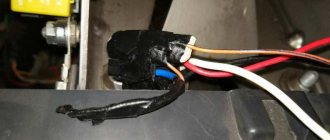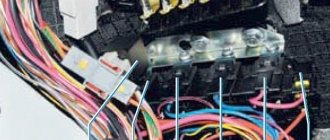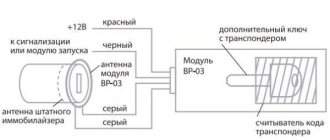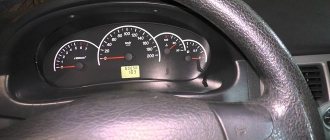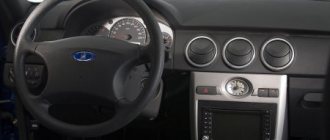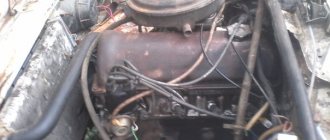January 15, 2015 Lada.Online 324 466 380
To start the engine, you need to ensure that a spark appears at a certain moment to ignite the air-fuel mixture in the cylinders. Problems with starting the engine occur if one or more elements of the system malfunction. The table lists possible reasons why the Priora does not start.
Why won't the engine start?
In order for the engine to start successfully, four conditions must be met. This is a sufficient crankshaft speed, a good level of compression, sufficient battery voltage, as well as the composition of the fuel mixture. Therefore, if a Priora car does not start, we can assume that some of the conditions are not met. To check this, you should analyze the situation.
If the unit does not want to start, then the first thing that is usually checked is the starter, battery, and high-voltage wires. Is the starter working normally, are there any suspicious sounds during its operation? Have the starter or battery been replaced? If the latter is discharged, then check the generator to see how well it charges the battery. Or maybe there are some problems in the electrical part? If you answer these questions, you can easily find out where the problem lies.
Main reasons
So, a man finds himself in an unpleasant situation when the starter of his Priora spins, but the engine does not start. There could be a whole bunch of reasons for this. It’s worth talking about them in more detail.
- 1. The fuse has blown
. In this case, you will need to check its integrity. To do this, you can use a special indicator in the form of a screwdriver or a tester. If these tools are not at hand, you will have to wait for help from passing drivers; - 2. The terminals
on the battery have oxidized or it is simply discharged. This seemingly typical car malfunction can serve as another reason. If the battery does not have enough voltage, it will be able to turn the starter, but there will not be enough charge to power the engine. It is worth checking the device to rule out this possibility; - 3. Defective ignition switch;
- 4. Corrosion. It can appear on any electrical part of the Priora. First of all, it is worth checking the starter itself, because it is always open to the flow of moist air, and this is the main cause of oxidation;
- 5. The ignition coil is faulty. This can also be checked by calling. For these purposes you will need a tester. If this part malfunctions, it must be replaced.
- 6. Accumulation of condensate
under the hood of the Priora; - 7. Fuel supply system problems
. This is very common in this kind of trouble. There are a whole bunch of devices that are responsible for the smooth operation of the system. It is not always possible to fix the problem yourself, so it is better to turn to professionals; - 8. Candles are flooded. And this problem can arise for every car enthusiast. In this case, it is imperative to use a spark plug tool to remove the spark plugs and then check their functionality. Sometimes just wiping them is enough, but sometimes they may need to be replaced. It is better to carry them in the trunk for this occasion;
- 9. Engine overheating
.
This is another nuisance that can lead to the car's operation being suspended. There could be many reasons for this. For example, there may simply be a leak of coolant from the expansion tank. There are many tubes coming out of it, so each of them may be faulty. Unstable operation of the thermostat, which is responsible for starting the engine, can also lead to the inability to start it. There is only one piece of advice here
- immediate replacement of the unit. There is so-called internal overheating, which is much worse than external overheating. While all sensors will definitely report the second option, the second option is practically indeterminable. You need to immediately contact the service for help.
Starting the Priora engine and battery
What happens when a warrior turns the key in the ignition and tries to start the engine? The starter starts and turns the crankshaft. If there is no reaction to turning the key, then look at the battery charge level. Most starters will not operate if the voltage drops below 10 volts. However, low voltages do not necessarily indicate problems with the battery. The battery could simply be discharged due to long attempts to start the car. The generator is also often to blame for insufficient charge. If not and there are similar symptoms, then experts recommend charging the battery and trying again after a while.
Summarizing
It is advisable that the starter spins the engine crankshaft during an attempt to start it for no more than 10 seconds, then the device must be given a minute pause. Failure to comply with this rule will, at best, lead to a discharge of the power source, and at worst, it will completely disable the starter. Only replacing it can save the situation, since not every auto electrician will undertake the task of rewinding burnt windings, since it is not always possible to perform this procedure efficiently. In addition, the cost of this service is comparable to the cost of a new element.
When I turn the ignition key, the car does not start. You can hear clicks and sometimes crunching sounds. You turn the key a few times and the car starts.
Today, when I turned the key, the lights on the instrument panel came on, but the starter did not react at all.
The battery terminals are secure and the battery is new. The starter was disassembled, washed and checked by closing the contacts. No deviations were found. Bosch starter
Generator testing
A properly functioning car alternator produces approximately 14 volts at idle speed with all electrical equipment turned off. At the time of the first start, the voltage should increase quickly - it will be 2 V or more. Then the current increase gradually decreases and levels off. This value will change depending on how charged the battery is, how much load is being placed on the bot network, and the temperature. The smaller it is, the higher the charge voltage. The charging current from a standard Priora generator can vary from 12.9 V to 14.8 V in frosty weather.
The starter does not turn or turns slowly
It happens that it does not and the starter does not rotate at all or rotates very slowly. In this case, it is recommended to focus on the element circuit. For quick diagnostics, turn on the headlights and observe what happens when the driver starts the engine. If the headlights begin to go out, this may indicate oxidized contacts of the traction relay and ground. In this case, it is recommended to carefully check the contacts.
Weak starter
If the Lada Priora does not start, then the possible reason is that the element is too weak. It simply cannot crank the crankshaft to the minimum 300 rpm. In this case, the required compression is not provided. Even if the starter manages to spin the crankshaft to the required speed, the engine still does not start, since all the battery energy is taken for spinning. It is not enough to operate the injectors and the ignition system.
Some tips
Did your car fail? Car owners complain that their car has difficulty starting when hot. If in the morning the vehicle can be started well, then after a short drive and turning off the engine, you will need to turn the starter while pressing the gas to start the engine. At the same time, it starts to smell like gasoline and stops for a few seconds.
Auto mechanics recommend solving this problem by replacing the following parts:
- spark plugs,
- fuel and air filters,
- installing a thick textolite gasket under the fuel pump,
- injectors,
- ignition module,
- water temperature sensor.
If the car has difficulty starting when cold, then the problem may be due to the use of low-quality gasoline. In this case, you must refuel only at trusted gas stations. Another reason why the Priora starts worse in cold weather is that the battery loses part of its capacity. The starter turns harder. The oil loses its viscosity and becomes thick. At low temperatures, it is recommended to fill in synthetics.
As a rule, to start the car, 1-2 rotations of the starter armature shaft are necessary. A vehicle in good condition will not have difficulty starting hot or cold. To do this, auto mechanics advise Lada Priora owners to adhere to the following recommendations:
| Advice | Explanation |
| Pour a lot of gasoline into the tank. | Otherwise, condensation will form. Water will not be able to get into the fuel. |
| Before starting your car in cold weather, you need to turn on the high beams for a couple of seconds. | This step will allow, in cold weather, to restore part of the vehicle’s capacity due to the processes occurring in the vehicle. |
| If there is an injector, then you will need to turn on the ignition and wait. The carburetor must be pumped with gasoline manually. | During this time, normal pressure will be created in the fuel system. In any case, do not overdo it, as the spark plugs will flood. |
| You can add a little gasoline to the oil before leaving home. | The car will cool down, and the oil will not lose its viscosity. When the car starts, the gasoline evaporates. The main thing is not to overfill the fuel. |
Check all components of the ignition system If these recommendations do not help and the engine does not start, then you need to check the ignition system.
Ignition system
The Priora does not start due to faults in the ignition system. Checking the ignition is quite simple. It is necessary to use a spark plug indicator or install a high-voltage wire near ground. If there is no spark, several malfunctions are possible - failure of the ignition unit, problems with the crankshaft position sensor, distributor sensor. For complete diagnostics, you can use the “Ignition System Simulator”. He will easily determine whether the coil and ignition unit can create a spark. If it is created, then look towards the distributor and crankshaft position sensors. If there is no spark, then it is the block or coil. By measuring the primary and secondary stresses on it, this element can be eliminated.
Hot
So, the car drove some distance. In the morning it started up with a half-turn, and forward. But then some distance was covered, a stop was made, the key was turned to “start” and... Several painful revolutions, and only then the engine started working. What's happened? As a rule, there can be many reasons. Conventionally, they can be divided into groups:
- The fuel system is acting up.
- Errors or breakdowns of sensors or actuators of the control system.
- Engine wear.
The first step is to check the presence of fuel in the injector frame. Gasoline supply is the most likely cause of problems. To do this, you need to open the hood and remove the decorative trim from the engine. The intake manifold runs between the engine and the Priora radiator. Below it is a fuel frame. At the end there is a special bypass valve, closed with a plastic cap. You need to unscrew it and press on the core. A strong release of fuel should occur.
When connecting this device, you need to turn on the ignition without trying to start it. The pressure must be at least 2.6. There is another option. Not so reliable, but quite usable. Perform the download several times before starting if the Priora is difficult to start. That is, without turning on the starter, wait until the fuel pump turns off, turn off the ignition and turn it on again without the starter. Do this several times. And then turn the engine. If starting improves, it means there was not enough pressure and you need to check the filters and fuel pump.
And another reason related to the fuel system is the banal clogging of the injectors, which gives the effect of poor starting to the same extent. But this is just a specialist checking the entire fuel frame at a special stand.
Electronic part of the check
Here it is worth clarifying immediately. There can be no talk of any complete determination of the cause of a poor startup without computer diagnostics. Although several positions can be checked. The easiest way is to check the performance of the Priora cylinders. To do this, you need to remove the decorative cover, start the engine and leave it at idle. Let it work a little and try to remove the connectors from the ignition modules one by one.
This requires good hearing and attentiveness. It is necessary to clearly determine which of the cylinders, when switched off, the operating rhythm changes the least.
Next, having determined the worst-performing “boiler”, perform the following actions:
- Using a 10 mm wrench, unscrew the bolts securing the modules from the “bad” and any other cylinder.
- Swap them and secure them.
- Repeat the procedure with listening. If the signs of a “bad” start move to another “boiler,” then the ignition module is to blame. And replace it.
- If no changes occur, then swap the spark plugs.
- Repeat the procedure again. If there is no change, then either the injector or wear in the cylinder is to blame.
In addition, one of the main sensors that controls the launch of the Priora is the mass air flow sensor (MAF).
Crankshaft position sensor
This is the main device that gives the start signal. If it fails, the car simply will not start. But there is a small nuance. If the damper is dirty, or a lot of dirt has adhered to the sensor itself, a “bad start” effect may occur. But it's easy enough to check. This device is installed on the oil pump housing to the left of the timing pulley. If it starts poorly, just visually examine its condition and clean it if necessary.
Poor starting due to engine wear
This is quite a rare occurrence. In general, VAZ 2170 Priora engines are quite durable with proper care. But as they say, even an old woman can get screwed. In this case, engine wear is determined by dark exhaust from the pipe and increased oil consumption. Well, in general, here you need specialist advice. The motor must be inspected by a mechanic. And do a compression test.


